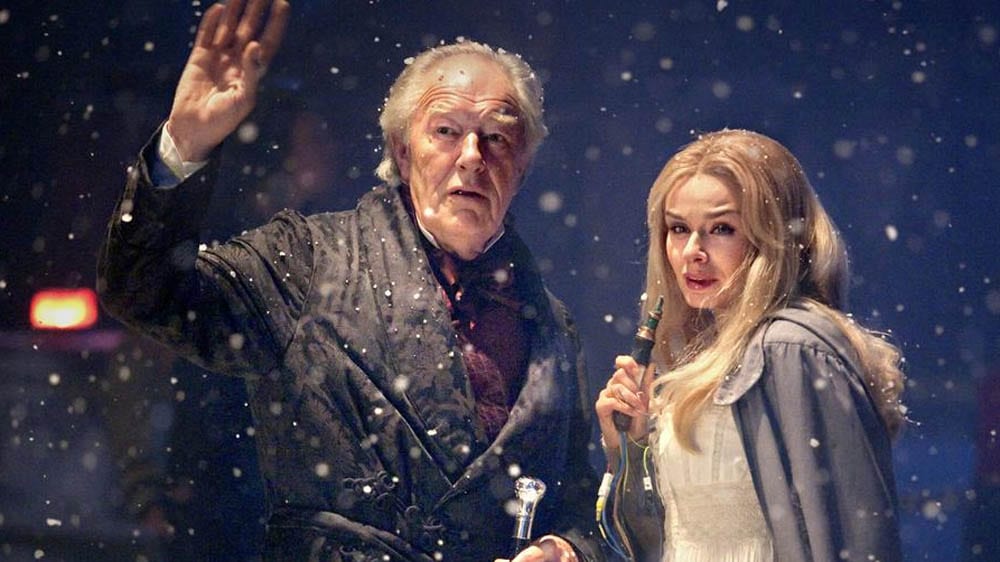Growing up in a primarily Jewish community in South Florida, Christmas was a lot like snow. I knew it was something most of America experienced in December, but it was foreign to me. It would periodically invade my home through commercials and episodes of my favorite shows where I would discover which of the supporting characters the writers had decided to make Jewish so that they could have someone quietly light a menorah after the main story was over but before everyone gathered around a big tree.
I wouldn’t celebrate my first Christmas until I was 23 and my boyfriend (who’s now my husband) decided it was time for me to meet his family. It was a whirlwind of introductions to aunts, uncles, cousins, and high school friends, but also to a host of new traditions. I was unsurprisingly pretty bad at putting up decorations and gift wrapping. I was really bad at Christmas music name that tune. But one tradition I could really get behind was the watching of movies.
My father-in-law collects versions of A Christmas Carol and likes to put them on in the background while doing any number of chores during the holiday season. Over the course of that weekend he would play the surprisingly disturbing Mickey’s Christmas Carol, a 1999 version starring Patrick Stewart as Scrooge, and the musical Mister Magoo’s Christmas Carol, all of which were new to me even if the plot wasn’t. Faith has its limits. In the same way my parents would never cook pork but often ordered spare ribs when we got Chinese takeout, their love for Bill Murray transcended their ambivalence about Christmas movies. We’d watched Scrooged several times and I enjoyed its modern metanarrative, where Murray’s Frank Cross is trying to put together a bombastic production of Charles Dickens’ story but has to actually learn the meaning behind it.

But I’d never seen a traditional version of the story until I watched the 1951 A Christmas Carol starring Alastair Sim. That film has more backstory than any of the others, with a particularly long Ghost of Christmas Past segment showing how Scrooge became so dour. (Weirdly enough the 2009 Jim Carrey version is one of the only others with this level of exposition.) Most tellings just show a young Scrooge partying at his old employer Fezziwig’s on Christmas and then breaking off his engagement because he’s putting money over love. The 1951 film goes far back to show Scrooge’s unhappy childhood, with holidays spent reading alone at boarding school. It shows how his sister defended him from their cruel father but died after giving birth, explaining in part Scrooge’s fraught relationship with his nephew. And it provides a longer chronicle of the decisions that Scrooge made to further his business career at the expense of personal relationships.
That backstory helped me connect with a character that often comes off as a caricature. Christmas is vaunted as a time to be with family, but if your relationships with your relatives is complicated the holiday loses that joy. This version showed Scrooge didn’t arbitrarily choose money over happiness. He’s just someone who fell into social isolation and clings to work above all else because it’s the one thing that makes sense. This version also has a particularly excellent Ghost of Christmas Future, abandoning the fear of hellfire that so often dominates that section and instead dwelling on how Scrooge would be remembered. It’s not fondly, with his servants and business colleagues only interested in his death insofar as it gives them an opportunity to steal his belongings or getting a free lunch at his funeral.
The strange thing about A Christmas Carol is that despite the name, it’s barely a Christmas story. There’s no Santa, no reindeer, and certainly no reference to the baby Jesus. It’s a weird ghost story with a humanist moral. Scrooge isn’t bad because he’s not going to church on Christmas, but because he’s not connecting with other people and is making everyone around him miserable. I was worried about feeling like an outsider that first Christmas, but better understanding this tradition made me feel included in the celebration in a new way.

That feeling was brought home years later when I watched Doctor Who’s version of A Christmas Carol. The episode gripped me immediately with an opening monologue that acknowledges Christmas is just one of many holidays celebrated by humans looking for a break from the oppressive darkness and cold of winter by gathering together around bright lights. It brought the Christian holiday and Hanukkah, the Jewish Festival of Lights, together in a way no number of mall displays ever had for me. Then it told a ridiculous story where Matt Smith tries to get an old man to be nicer so he’ll turn off some cloud controlling technology and let an ailing space liner land.
The Ghost of Christmas Past is one of the best parts here as well. The Doctor attempts to convince Kazran Sardick to change his ways by using time travel to give him a happier childhood, and having the liner’s passengers appear to him as holograms in a version of the Ghost of Christmas Present. Kazran dares the Doctor to show him some vision of his future, saying he already accepts that he will die alone and afraid. But instead the vision is given to a younger version of Kazran himself, who looks with horror at the man he will become. The episode stresses the importance of living your best life and accepting loss, which are values that are particularly relevant when your holidays are less than perfect. Plus there are flying sharks.
I live in Chicago now and snow is a stark fact in December. My house is decorated with a mix of Christmas lights and paper lanterns depicting menorahs and dreidels. Over the years we’ve celebrated with a mix of big Christmas dinners and ordering Chinese food and seeing a movie in the tradition of my people. The holidays are a complicated time, but no matter how you celebrate it’s worth checking out a version of A Christmas Carol and enjoying its message of the importance of taking time off to reassess the person you want to be.





